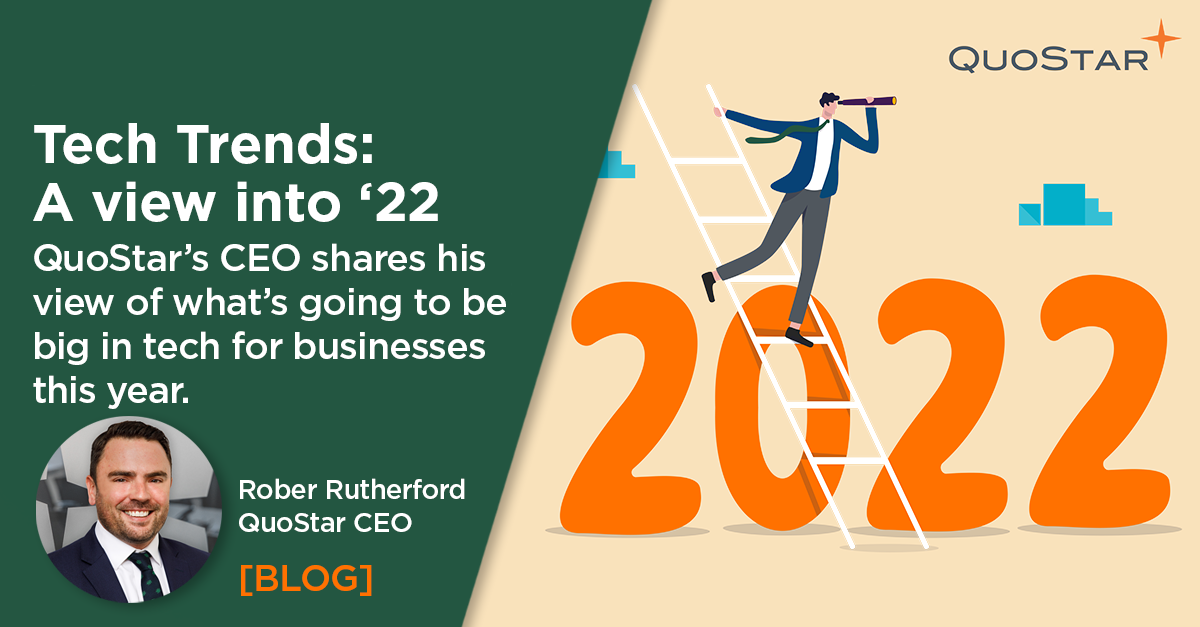
QuoStar CEO Robert Rutherford looks to the future, sharing his view of what’s going to be big for businesses this year.
Tech trends in 2022.
A shortage of tech talent will widen and rapidly develop the global IT skills market
There is a significant skill shortage in the UK from an IT perspective, which has been coming for some time due to numerous factors. The COVID crisis has certainly added fuel to the fire, as businesses have got used to working effectively with staff and 3rd party suppliers in a digital-only manner. This will certainly push more and more businesses to outsource parts of IT service, development, and other IT projects to outside partners.
You’ll see many businesses reach overseas to where the talent lies at the perceived right price. However, they are going to have to be extremely careful, especially where service is involved. The management overhead is also often underestimated, both during start up and day to day operations. You really need experienced and proven managers and frameworks to get the overseas play correct. The lure of ‘cheap’ labour always has hidden costs.
Digital First a core strategy
Anything that can be done digitally will be getting real focus in 2022. In any new business and departmental strategy, or project that involves a process or a procedure (most, if not all), a digital solution will gain extra weight by default. This is going to be driven by a need to improve efficiency, margin, and security, whilst also improving the user or customer experience. Of course, a digital first strategy doesn’t mean that every operation and interaction must be digitised, but it must be considered.
It is important that digitisation isn’t viewed as simply purchasing technology to solve problems. It’s about understanding the operations and processes (systems) within a business operation and choosing the right technological change or transformation to achieve a business result that is both measurable and positive. This is certainly going to lead to a board having to really get to grips with the strategic use of IT, whilst also bringing in senior IT professionals, such as a CIO, into the core of the business decision making process.
CRM technologies and their uptake will develop quickly
CRM growth has been ramping over the last few years due to customers’ service demands and expectations. Again, due to COVID, the expectation for rapid and effective service in a personalised manner has increased. The fact that most markets have in effect got smaller due to globalisation, businesses are going to need to do more to mine and utilise their data to compete and hold market-share.
It should be noted that CRM is not simply an IT project. It’s really an organisational transformation piece that involves most of the business, and it can take a year or more to even begin to realise the true value it can deliver. Too many businesses have been flying out to ‘buy’ a CRM post-COVID, which will typically lead to a failed ‘business’ project.
Automation will become essential
Due to skills shortages and growing competition, businesses are going to need to get leaner and smarter in how their operations and services are delivered. AI and other technologies are certainly going to help, however businesses do need to take responsibility for truly understanding, mapping and measuring their processes. This is where organisations can protect, as well as increase their margins, plus improve employee and client satisfaction.
You are certainly going to see process improvement and automation come down into the small and mid-market, as margins get squeezed, as the world effect becomes smaller, and as the pace of change ramps – fuelled again by COVID. The demand for systems and business analysts is certainly going to rise, but again the UK is significantly disadvantaged due to a lack of strategy from successive governments. Businesses are often going to need to train and develop their own talent to deliver initial and ongoing value.
Improvement in the User Experience
Many industries have been really let down by their main Line of Business vendors, in terms of the Customer Experience (CX), support and product development. This is going to create real friction points due to the more fractured way of working. Software vendors and those providing services to customers online are really going to have to work hard to ensure their products and service offerings better fit the new working model, in terms of the user’s experience.
Businesses are also going to have to consider how easy it is for their staff to complete their duties, especially when working in a remote manner. Are they really as effective as they should be? Is their working experience acceptable? Can they get support when they need it, i.e. 24x7x365? There is a growing trend of staff leaving businesses where they feel the technology and support overlays are holding them back.
Cloud workloads move around
There’s been a rush to the cloud prior, and during the pandemic, particularly the public cloud, and predominately Microsoft Azure for day-to-day operations infrastructure and systems. However, the cloud markets move extremely quickly, and a single infrastructure doesn’t fit all workloads, in terms of functionality, security, performance, interoperability and price. The market is pushing private and public vendors to compete within these areas and thus splitting workloads between public and private cloud. A true hyper-connected hybrid model will typically deliver organisations the best value going forward, right now and ongoing.
The rise of cloud multi-platform management, automation tools and the competitive landscape continues to drive innovation and creates specialist vendors and cloud providers. It’s continually becoming simpler to run, manage and migrate between different cloud vendors and platforms with ease. The shift is certainly empowering and aiding the customer. You’ll certainly see more workloads (not entire infrastructures) reverse out of the large public cloud providers into niche players who can deliver greater support, performance, and operational value to specific sectors.
ZTNA becomes the focus
The rapid escalation of remote working has dramatically increased the risk profile of a large percentage of operations. This will rapidly move the focus and ramp adoption of Zero Trust Network Access (ZTNA) – the Gartner coined term to enable greater control and security of network access.
Traditional VPN type connections are clunky and can be slow, they also consume significant resources, in terms of equipment and management overheads. Organisations will look to ZTNA to improve the granularity of control of their remote workforces’ access to corporate systems, whilst also simplifying it through ABAC (Attribute Based Access Control) and RBAC (Role Based Access Control). There’s too much to go into here but the rise of cybercrime led by organised gangs focused on monetary rewards means that every door must be locked shut, whilst also not hampering the user experience.
Cyber security becomes board’s problem
Many leadership teams have had some experience of cyber security, due to experiencing a painful incident or perhaps implementing Cyber Essentials (the very basics). However, due to the risk landscape being so huge, and the impact of a security incident being so great, boards are going to have to take the reins on risk management from a cyber security perspective. They are going to have to fully understand risks and controls, thus expect to see a ramp in the demand for Information Security Management Systems (ISMS’s) and the experience of a CISO.
If a board doesn’t insist on an ISMS to ensure that Information Security is managed appropriately then in reality, they are being negligent; regulators know that, as do customers and insurers. No longer can the board leave Information Security to the IT team, they are going to have to take direct responsibility for some of the largest risks their businesses face.
If you’d like to discuss improving your business IT in 2022 get in touch here.
